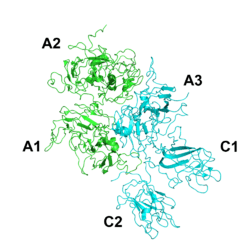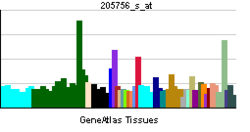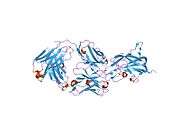Factor VIII
| View/Edit Human | View/Edit Mouse |
Factor VIII (FVIII) is an essential blood-clotting protein, also known as anti-hemophilic factor (AHF). In humans, factor VIII is encoded by the F8 gene.[4][5] Defects in this gene results in hemophilia A, a recessive X-linked coagulation disorder.[6] Factor VIII is produced in liver sinusoidal cells and endothelial cells outside of the liver throughout the body. This protein circulates in the bloodstream in an inactive form, bound to another molecule called von Willebrand factor, until an injury that damages blood vessels occurs.[7] In response to injury, coagulation factor VIII is activated and separates from von Willebrand factor. The active protein (sometimes written as coagulation factor VIIIa) interacts with another coagulation factor called factor IX. This interaction sets off a chain of additional chemical reactions that form a blood clot.[7]
Factor VIII participates in blood coagulation; it is a cofactor for factor IXa which, in the presence of Ca2+ and phospholipids forms a complex that converts factor X to the activated form Xa. The factor VIII gene produces two alternatively spliced transcripts. Transcript variant 1 encodes a large glycoprotein, isoform a, which circulates in plasma and associates with von Willebrand factor in a noncovalent complex. This protein undergoes multiple cleavage events. Transcript variant 2 encodes a putative small protein, isoform b, which consists primarily of the phospholipid binding domain of factor VIIIc. This binding domain is essential for coagulant activity.[8]
People with high levels of factor VIII are at increased risk for deep vein thrombosis and pulmonary embolism.[9] Copper is a required cofactor for factor VIII and copper deficiency is known to decrease levels of factor VIII.[10]
It is on the WHO Model List of Essential Medicines, the most important medications needed in a basic health system.[11]
Genetics
The gene for factor VIII is located on the X chromosome (Xq28). The gene for factor VIII presents an interesting primary structure, as another gene is embedded in one of its introns.[12]
Structure
Factor VIII protein consists of six domains: A1-A2-B-A3-C1-C2, and is homologous to factor V.
The A domains are homologous to the A domains of the copper-binding protein ceruloplasmin.[13] The C domains belong to the phospholipid-binding discoidin domain family, and the C2 domain mediate membrane binding.[14]
Activation of factor VIII to factor VIIIa is done by cleavage and release of the B domain. The protein is now divided to a heavy chain, consisting of the A1-A2 domains, and a light chain, consisting of the A3-C1-C2 domains. Both form non-covalently a complex in a calcium-dependent manner. This complex is the pro-coagulant factor VIIIa.[15]
Physiology
FVIII is a glycoprotein procofactor. Although the primary site of release in humans is ambiguous, it is synthesized and released into the bloodstream by the vascular, glomerular, and tubular endothelium, and the sinusoidal cells of the liver.[16] Hemophilia A has been corrected by liver transplantation.[17] Transplanting hepatocytes was ineffective, but liver endothelial cells were effective.[17]
In the blood, it mainly circulates in a stable noncovalent complex with von Willebrand factor. Upon activation by thrombin, (factor IIa), it dissociates from the complex to interact with factor IXa in the coagulation cascade. It is a cofactor to factor IXa in the activation of factor X, which, in turn, with its cofactor factor Va, activates more thrombin. Thrombin cleaves fibrinogen into fibrin which polymerizes and crosslinks (using factor XIII) into a blood clot.
No longer protected by vWF, activated FVIII is proteolytically inactivated in the process (most prominently by activated protein C and factor IXa) and quickly cleared from the blood stream.
Factor VIII is not affected by liver disease. In fact, levels usually are elevated in such instances.[18][19]
Medical use
FVIII concentrated from donated blood plasma (Aafact or Alphanate, Monoclate-P®), or alternatively recombinant FVIII can be given to hemophiliacs to restore hemostasis.
The transfer of a plasma byproduct into the blood stream of a patient with hemophilia often led to the transmission of diseases such as hepatitis B and C and HIV before purification methods were improved.
Antibody formation to factor VIII can also be a major concern for patients receiving therapy against bleeding; the incidence of these inhibitors is dependent of various factors, including the factor VIII product itself.[20]
Contamination scandal
In the 1980s, some pharmaceutical companies such as Bayer sparked controversy by continuing to sell contaminated factor VIII after new heat-treated versions were available.[21] Under FDA pressure, unheated product was pulled from US markets, but was sold to Asian, Latin American, and some European countries. The product was tainted with HIV, a concern that had been discussed by Bayer and the U.S. Food and Drug Administration (FDA).[21]
In the early 1990s, pharmaceutical companies began to produce recombinant synthesized factor products, which now prevent nearly all forms of disease transmission during replacement therapy.
See also
References
- ↑ "Diseases that are genetically associated with F8 view/edit references on wikidata".
- ↑ "Human PubMed Reference:".
- ↑ "Mouse PubMed Reference:".
- ↑ Toole JJ, Knopf JL, Wozney JM, Sultzman LA, Buecker JL, Pittman DD, Kaufman RJ, Brown E, Shoemaker C, Orr EC (1984). "Molecular cloning of a cDNA encoding human antihaemophilic factor". Nature. 312 (5992): 342–7. doi:10.1038/312342a0. PMID 6438528.
- ↑ Truett MA, Blacher R, Burke RL, Caput D, Chu C, Dina D, Hartog K, Kuo CH, Masiarz FR, Merryweather JP (October 1985). "Characterization of the polypeptide composition of human factor VIII:C and the nucleotide sequence and expression of the human kidney cDNA". DNA. 4 (5): 333–49. doi:10.1089/dna.1985.4.333. PMID 3935400.
- ↑ Antonarakis SE (July 1995). "Molecular genetics of coagulation factor VIII gene and hemophilia A". Thromb. Haemost. 74 (1): 322–8. PMID 8578479.
- 1 2 "NIH: F8 - coagulation factor VIII". National Institutes of Health.
- ↑ "Entrez Gene: F8 coagulation factor VIII, procoagulant component (hemophilia A)".
- ↑ Jenkins PV, Rawley O, Smith OP, et al. (2012). "Elevated factor VIII levels and risk of venous thrombosis". Br J Haematol. 157 (6): 653–63. doi:10.1111/j.1365-2141.2012.09134.x. PMID 22530883.
- ↑ Milne, David B; Nielsen Forrest H. (1996). "Effects of a diet low in copper on copper-status indicators in postmenopausal women.". Am J Clin Nutr. 63 (3): 358–64. PMID 8602593.
- ↑ "19th WHO Model List of Essential Medicines (April 2015)" (PDF). WHO. April 2015. Retrieved May 10, 2015.
- ↑ Levinson B, Kenwrick S, Lakich D, Hammonds G, Gitschier J (1990). "A transcribed gene in an intron of the human factor VIII gene". Genomics. 7 (1): 1–11. doi:10.1016/0888-7543(90)90512-S. PMID 2110545.
- ↑ Villoutreix BO, Dahlbäck B (Jun 1998). "Structural investigation of the A domains of human blood coagulation factor V by molecular modeling". Protein science. 7 (6): 1317–1325. doi:10.1002/pro.5560070607. PMC 2144041
 . PMID 9655335.
. PMID 9655335. - ↑ Macedo-Ribeiro S, Bode W, Huber R, Quinn-Allen MA, Kim SW, Ortel TL, et al. (Nov 1999). "Crystal structures of the membrane-binding C2 domain of human coagulation factor V". Nature. 402 (6760): 434–439. doi:10.1038/46594. PMID 10586886.
- ↑ Thorelli E, Kaufman RJ, Dahlbäck B (Jun 1998). "The C-terminal region of the factor V B-domain is crucial for the anticoagulant activity of factor V". Journal of Biological Chemistry. 273 (26): 16140–16145. doi:10.1074/jbc.273.26.16140. PMID 9632668.
- ↑ Kumar; Abbas; Fausto (2005). Robbins and Cotran Pathologic Basis of Disease. Pennsylvania: Elsevier. p. 655. ISBN 1-889325-04-X.
- 1 2 Kaushansky K, Lichtman M, Beutler E, Kipps T, Prchal J, Seligsohn U. (2010; edition 8) Williams Hematology. McGraw-Hill. ISBN 978-0-07-162151-9
- ↑ Hollestelle, MJ; Geertzen, HG; Straatsburg, IH; van Gulik, TM; van Mourik, JA (Feb 2004). "Factor VIII expression in liver disease.". Thrombosis and haemostasis. 91 (2): 267–75. doi:10.1160/th03-05-0310. PMID 14961153.
- ↑ R. Rubin; L. Leopold (1998). Hematologic Pathophysiology. Madison, Conn: Fence Creek Publishing. ISBN 1-889325-04-X.
- ↑ Lozier J (2004). "Overview of Factor VIII Inhibitors". CMEonHemophilia.com. Retrieved 2009-01-07.
- 1 2 Bogdanich W, Koli E (2003-05-22). "2 Paths of Bayer Drug in 80's: Riskier One Steered Overseas". The New York Times. Retrieved 2009-01-07.
Further reading
- Gitschier J (1991). "The molecular basis of hemophilia A". Ann. N. Y. Acad. Sci. 614 (1 Process in Va): 89–96. doi:10.1111/j.1749-6632.1991.tb43694.x. PMID 1902642.
- White GC, Shoemaker CB (1989). "Factor VIII gene and hemophilia A". Blood. 73 (1): 1–12. PMID 2491949.
- Antonarakis SE, Kazazian HH, Tuddenham EG (1995). "Molecular etiology of factor VIII deficiency in hemophilia A". Hum. Mutat. 5 (1): 1–22. doi:10.1002/humu.1380050102. PMID 7728145.
- Lenting PJ, van Mourik JA, Mertens K (1999). "The life cycle of coagulation factor VIII in view of its structure and function". Blood. 92 (11): 3983–96. PMID 9834200.
- Saenko EL, Ananyeva N, Kouiavskaia D, et al. (2003). "Molecular defects in coagulation Factor VIII and their impact on Factor VIII function". Vox Sang. 83 (2): 89–96. doi:10.1046/j.1423-0410.2002.00183.x. PMID 12201837.
- Lollar P (2003). "Molecular characterization of the immune response to factor VIII". Vox Sang. 83. Suppl 1: 403–8. doi:10.1111/j.1423-0410.2002.tb05342.x. PMID 12617176.
- Fay PJ (2004). "Activation of factor VIII and mechanisms of cofactor action". Blood Rev. 18 (1): 1–15. doi:10.1016/S0268-960X(03)00025-0. PMID 14684146.
- Lavigne-Lissalde G, Schved JF, Granier C, Villard S (2005). "Anti-factor VIII antibodies: a 2005 update". Thromb. Haemost. 94 (4): 760–9. doi:10.1160/TH05-02-0118. PMID 16270627.
- Fang H, Wang L, Wang H (2007). "The protein structure and effect of factor VIII". Thromb. Res. 119 (1): 1–13. doi:10.1016/j.thromres.2005.12.015. PMID 16487577.
External links
- GeneReviews/NCBI/NIH/UW entry on Hemophilia A
- The Coagulation Factor VIII Protein
- Factor VIII at the US National Library of Medicine Medical Subject Headings (MeSH)



